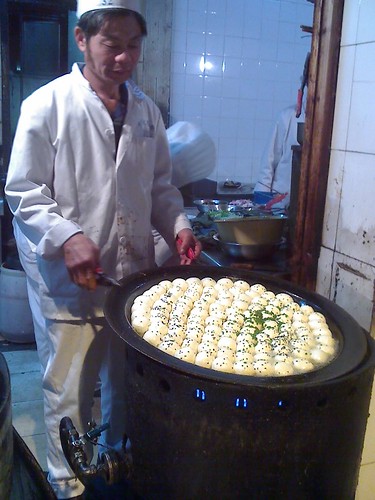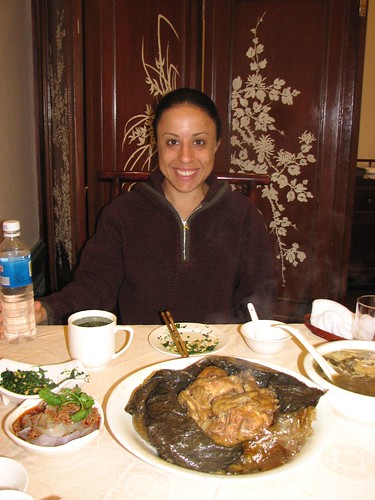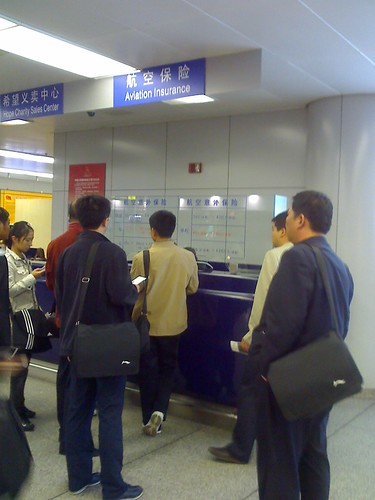Monday, November 26, 2007
Honor thy elders
That's a headline from today's China Daily. "Time-honored"is a phrase I hear at least once or twice a week in China. It seems odd to me, since it is hardly ever used in the US. According to Merriam-Webster, it means "honored because of age or long usage." I suppose that's a typical Chinese sentiment -- since something has been around a long time, it should be treasured and honored.
While that may be true for things like the Forbidden City and the Great Wall, should the term really be used for a 147 year old restaurant that serves really greasy duck mostly to tourists? Or how about China's relationship with South Africa? I also discovered that there is an official list of "time-honored" brands in China. There are 430 of them to be exact. At least, that was the number in 2006. Who knows, another year has passed and perhaps many more have withstood the test of time and deserve the title.
Quick visit to Kuala Lumpur

I was in Kuala Lumpur, Malaysia last week for a very short training session. I wish I could have spent more time there, as it seemed like a very interesting place. Very similar to Singapore (which is less than 300 km away), but seemed more genuine and definitely more Muslim. Even though I spent 90% of my time in the hotel where the training was held, I did get a chance to visit the Petronas Towers, formerly the tallest buildings in the world (first surpassed by Taipei 101, and now the Burj Dubai).
Malaysian food is supposed to be good, and Chinese cuisine mixed with Indian spices and Muslim influences make for some interesting flavors. While I certainly enjoyed it, I wouldn’t say it’s as good as the Thai food I had in Thailand or the stuff I had in hawker stalls in Singapore.
Chinese conformity has its advantages

I snapped this picture last week during a flight delay. All the passengers are eating the same thing. It’s a free meal provided by the airline to the delayed passengers. While I am impressed that Chinese airlines are sufficiently service-oriented to provide such a freebie, the approach is typically Chinese. The free meals are all the same; you get a mixed plate containing rice, a pork chop, pickled vegetables and fruit. You also get a can of Coke. No vegetarian option or Diet Coke. All the passengers were thrilled to take it. Contrast this with the American approach of providing meal vouchers so that people can choose their own meals. I’m not sure which is more efficient. Certainly it’s not worthwhile for airlines to provide different kinds of meals at the airport when there are so many restaurants available that probably run a more efficient kitchen than an airline. However, when hundreds of Chinese travelers are happy to eat the same slop, it’s probably pretty cheap.
Friday, November 23, 2007
41 degrees and partly smoky
 Beijing weather is pretty bad. During the summer, sandstorms blow in from the West. During the winter, the air is so dry every cubicle in corporate offices will have a rising column of steam coming out of a humidifier. However, last week, it was "smoky" in Beijing, at least according to my Accuweather forecast. When I looked out the window, I didn't notice any substantial difference from the typical "partly cloudy" or "foggy" descriptions.
Beijing weather is pretty bad. During the summer, sandstorms blow in from the West. During the winter, the air is so dry every cubicle in corporate offices will have a rising column of steam coming out of a humidifier. However, last week, it was "smoky" in Beijing, at least according to my Accuweather forecast. When I looked out the window, I didn't notice any substantial difference from the typical "partly cloudy" or "foggy" descriptions.
Exchange rate via Economist cover price
China: RMB 75 – US$10
Hong Kong: HK$60 – US$8
Taiwan: NT$230 – US$7
Japan: ¥1,150 – US$10
Korea: Won 8,500 – US$9
Singapore: S$12 – US$8
Malaysia: RM18 – US$6
Vietnam, Tonga, Fiji, & Mongolia: US$6
I can understand why Japan is expensive. Everything in Japan is expensive, and I’m sure the extra cost is to give Japan’s backward retail sector enough margin to sell a copy at a profit. But China? Why is it 66% more expensive for the Economist in China compared to Mongolia? Perhaps I could make money importing black market copies over the border from Mongolia into Inner Mongolia, China.
Saturday, November 17, 2007
130k+ Chens, 400k+ Nguyens in the United States
For instance, if I make the assumption that there are about 350 million people in the United States, there are the following number of people with these respective family names:
Nguyen: 400,000
Kim: 250,000
Patel: 190,000
Chen: 130,000
Park: 105,000
I know there are a lot of Vietnamese living in the US, according to wikipedia (via Answers.com since I can't actually access wikipedia in China) there were 1.2 million in 2000. That would mean 1/3 of all Vietnamese have the last name Nguyen.
As a consultant, I wish I had the raw census data historically as well so I could do comparison of trends. Potential changes include the popularity of Chinese pinyin spellings of Chinese surnames. For now, older Wade-Giles spellings (look it up on wikipedia, I can't paste the link) are still more popular. Here is the prevalence per 100,000 names.
Chang 26 vs. Zhang 12
Hsu 6 vs. Xu 5
Wong 37 vs. Wang 25
Ho 15 vs. He 3
Best xiao long bao in Shanghai
The International Herald Tribune has now gotten into the game of finding the best xiao long bao in Shanghai. Others have been down this road before, but does the prestige of the IHT unveil anything new? Nope, Din Tai Fung it is. When does this stop being a question that still needs to be answered? Yes, the restaurant got its start in Taiwan, and yes, it doesn't meet that food traveler qualification of being off the beaten path and cheap as hell. Let's live with the fact that the best xiao long bao in town does indeed reside inside a fashion mall at the tail end of touristy Xintiandi.
Monday, November 12, 2007
Pearls in Shanghai
 There is a pearl shop in Shanghai that we've visited countless times -- over the last year we've been there so often they keep record of our purchases and know all about us and our friends/family (especially the people for whom we are buying gifts). Now they are putting Katie to work. Here she is drilling holes for earring posts into two large pearls that she is buying for a friend.
There is a pearl shop in Shanghai that we've visited countless times -- over the last year we've been there so often they keep record of our purchases and know all about us and our friends/family (especially the people for whom we are buying gifts). Now they are putting Katie to work. Here she is drilling holes for earring posts into two large pearls that she is buying for a friend.
Amusing recent travel pictures
Sunday, November 11, 2007
Sampling of food pictures
Fried soup buns -- Katie's favorite Shanghai treat (3 RMB for 4)

I don't remember what this cilantro-greens-tofu chopped salad is called - but it's delicious. Courtesy of Ding Tai Feng (20 RMB)

Pork floss waffle. Weird combination that was overpriced due to its airport location (60 RMB)

Beggars chicken from the famous Hangzhou restaurant Louwailou, where my grandparents honeymooned many years ago (158 RMB for one chicken -- What beggar can afford that?)

Dinner at Shanghai's opulent Whampoa Club (688 RMB for 5 courses and wine)

Saturday, November 10, 2007
Chinese economy
Especially when it comes to China, I believe in anecdotal data. You can't trust what the government says, so for instance, if you want to know the true exchange rate, you can go to the black market dealers (who are offering 7.3 RMB to the dollar) or use the Economist Big Mac Index (which says the exchange rate should be closer to 3.2 RMB to the dollar).
My own experience also shows inflation is running rampant:
(1) Last week, I went to a food stall to buy fried soup dumplings. I've been there numerous times before after discovering the place during my first week in Shanghai. In January, I paid 2 RMB for 4. In October, when I brought my friends there, the price had been raised to 2.5 RMB. When I took Katie there last week, it had been raised again to 3 RMB. Annualized, that inflation rate is higher than 60%.
(2) My rent is currently 7200/month. The signs I see posted outside my building show the same unit layout is now listed at 9000/month. Sure, there may be some room for negotiation, but even cutting 10% off that rent would mean an 800 RMB/month increase - implying a 12.5% inflation rate.
(3) Gas prices were just raised 10% (by the central government no less). Since when do >10% increases in energy, food, and housing lead to a overall inflation rate of below 5%? There may be some poor farmers in the middle of Anhui not seeing an increase in their costs of living, but I doubt they are somehow getting specially-priced gas or pork in their towns as well.
In other news, the Shanghai stock index is still above 6000, despite a recent selloff. That's 50% higher than when I first moved to Shanghai and spoke about the bubble. The price/earnings ratio is also hitting highs of 39:1. The S&P 500 by contrast is at 16.
Hangzhou is heaven on earth

Katie came to China last week, so I took a break from posting.
As I predicted she was on the phone a lot and woke up to check emails multiple times each night, but she still managed to stay awake during the day and we had a great time. We were in Shanghai for a majority of her visit, but we took quick trips to Beijing and Hangzhou.
Despite the luxury of the St. Regis, the Beijing trip confirmed Katie's general distaste for the traffic, bad pollution, and communist feeling in the north. Hanzhou was another story. The Chinese have a saying that "Up above, there is heaven, on the ground, there is Suzhou and Hangzhou." We had been to Suzhou during her last trip, and let me tell you: it may have been beautiful, but the gardens are now surrounded by industrial parks and filled with green trees covered in brown dust.
However, Hangzhou was indeed very pretty. Hangzhou is dominated by West Lake and surrounded by a few low mountains. We didn't get a chance to go into the mountains, which are well known for growing tea and bamboo. But our time spent on the lake was quite nice. There aren't the crowds of people found in other tourist locations, and the lake is still well maintained by the local government. Also, the local Hangzhou cuisine is incredible.
The recently unveiled D-class trains (China rolls out faster and faster service each year, and changes the train lettering to let you know how fast that particular train will go) hit 180 km/h (110 mph) and go straight from Shanghai South Railway station to downtown Hangzhou in one hour and 15 minutes for the round trip cost of 128 RMB ($17). I highly recommend the trip.


